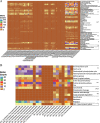Bacteria and Archaea Regulate Particulate Organic Matter Export in Suspended and Sinking Marine Particle Fractions
- PMID: 37093039
- PMCID: PMC10286711
- DOI: 10.1128/msphere.00420-22
Bacteria and Archaea Regulate Particulate Organic Matter Export in Suspended and Sinking Marine Particle Fractions
Abstract
The biological carbon pump (BCP) in the Southern Ocean is driven by phytoplankton productivity and is a significant organic matter sink. However, the role of particle-attached (PA) and free-living (FL) prokaryotes (bacteria and archaea) and their diversity in influencing the efficiency of the BCP is still unclear. To investigate this, we analyzed the metagenomes linked to suspended and sinking marine particles from the Sub-Antarctic Southern Ocean Time Series (SOTS) by deploying a Marine Snow Catcher (MSC), obtaining suspended and sinking particulate material, determining organic carbon and nitrogen flux, and constructing metagenome-assembled genomes (MAGs). The suspended and sinking particle-pools were dominated by bacteria with the potential to degrade organic carbon. Bacterial communities associated with the sinking fraction had more genes related to the degradation of complex organic carbon than those in the suspended fraction. Archaea had the potential to drive nitrogen metabolism via nitrite and ammonia oxidation, altering organic nitrogen concentration. The data revealed several pathways for chemoautotrophy and the secretion of recalcitrant dissolved organic carbon (RDOC) from CO2, with bacteria and archaea potentially sequestering particulate organic matter (POM) via the production of RDOC. These findings provide insights into the diversity and function of prokaryotes in suspended and sinking particles and their role in organic carbon/nitrogen export in the Southern Ocean. IMPORTANCE The biological carbon pump is crucial for the export of particulate organic matter in the ocean. Recent studies on marine microbes have shown the profound influence of bacteria and archaea as regulators of particulate organic matter export. Yet, despite the importance of the Southern Ocean as a carbon sink, we lack comparable insights regarding microbial contributions. This study provides the first insights regarding prokaryotic contributions to particulate organic matter export in the Southern Ocean. We reveal evidence that prokaryotic communities in suspended and sinking particle fractions harbor widespread genomic potential for mediating particulate organic matter export. The results substantially enhance our understanding of the role played by microorganisms in regulating particulate organic matter export in suspended and sinking marine fractions in the Southern Ocean.
Keywords: Marine Snow Catcher; Southern Ocean; carbon export; functional capacity; marine fractions; metagenomics; particulate organic matter; prokaryotes.
Conflict of interest statement
The authors declare no conflict of interest.
Figures





Similar articles
-
Diverse Genomic Traits Differentiate Sinking-Particle-Associated versus Free-Living Microbes throughout the Oligotrophic Open Ocean Water Column.mBio. 2022 Aug 30;13(4):e0156922. doi: 10.1128/mbio.01569-22. Epub 2022 Jul 12. mBio. 2022. PMID: 35862780 Free PMC article.
-
Biological composition and microbial dynamics of sinking particulate organic matter at abyssal depths in the oligotrophic open ocean.Proc Natl Acad Sci U S A. 2019 Jun 11;116(24):11824-11832. doi: 10.1073/pnas.1903080116. Epub 2019 May 24. Proc Natl Acad Sci U S A. 2019. PMID: 31127042 Free PMC article.
-
Prokaryotic niche partitioning between suspended and sinking marine particles.Environ Microbiol Rep. 2019 Jun;11(3):386-400. doi: 10.1111/1758-2229.12692. Epub 2018 Oct 16. Environ Microbiol Rep. 2019. PMID: 30246414
-
Microbial production of recalcitrant dissolved organic matter: long-term carbon storage in the global ocean.Nat Rev Microbiol. 2010 Aug;8(8):593-9. doi: 10.1038/nrmicro2386. Epub 2010 Jul 5. Nat Rev Microbiol. 2010. PMID: 20601964 Review.
-
Mechanisms and Pathways of Small-Phytoplankton Export from the Surface Ocean.Ann Rev Mar Sci. 2019 Jan 3;11:57-74. doi: 10.1146/annurev-marine-121916-063627. Epub 2018 Jul 11. Ann Rev Mar Sci. 2019. PMID: 29996063 Review.
Cited by
-
The Cœlomic Microbiota Among Three Echinoderms: The Black Sea Cucumber Holothuria forskali, the Sea Star Marthasterias glacialis, and the Sea Urchin Sphaerechinus granularis.Biology (Basel). 2025 Apr 16;14(4):430. doi: 10.3390/biology14040430. Biology (Basel). 2025. PMID: 40282295 Free PMC article.
-
Fate and carbon sequestration potential of sunken macroalgae in coastal oceans from long-term microbial degradation perspective.Natl Sci Rev. 2025 Jul 8;12(8):nwaf273. doi: 10.1093/nsr/nwaf273. eCollection 2025 Aug. Natl Sci Rev. 2025. PMID: 40842870 Free PMC article.
-
Diversity, community structure, and abundance of nirS-type denitrifying bacteria on suspended particulate matter in coastal high-altitude aquaculture pond water.Sci Rep. 2024 Mar 7;14(1):5594. doi: 10.1038/s41598-024-56196-x. Sci Rep. 2024. PMID: 38454013 Free PMC article.
-
Community structure and carbon metabolism functions of bacterioplankton in the Guangdong coastal zone.Mar Life Sci Technol. 2024 Jul 29;6(3):547-561. doi: 10.1007/s42995-024-00245-x. eCollection 2024 Aug. Mar Life Sci Technol. 2024. PMID: 39219687 Free PMC article.
References
-
- Friedlingstein P, Jones MW, O'Sullivan M, Andrew RM, Hauck J, Peters GP, Peters W, Pongratz J, Sitch S, Le Quéré C, Bakker DCE, Canadell JG, Ciais P, Jackson RB, Anthoni P, Barbero L, Bastos A, Bastrikov V, Becker M, Bopp L, Buitenhuis E, Chandra N, Chevallier F, Chini LP, Currie KI, Feely RA, Gehlen M, Gilfillan D, Gkritzalis T, Goll DS, Gruber N, Gutekunst S, Harris I, Haverd V, Houghton RA, Hurtt G, Ilyina T, Jain AK, Joetzjer E, Kaplan JO, Kato E, Klein Goldewijk K, Korsbakken JI, Landschützer P, Lauvset SK, Lefèvre N, Lenton A, Lienert S, Lombardozzi D, Marland G, et al. . 2019. Global carbon budget 2019. Earth Syst Sci Data 11:1783–1838. doi:10.5194/essd-11-1783-2019. - DOI
MeSH terms
Substances
Grants and funding
LinkOut - more resources
Full Text Sources
